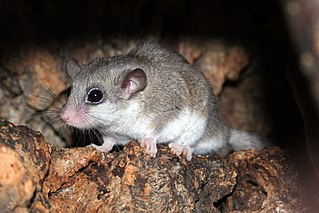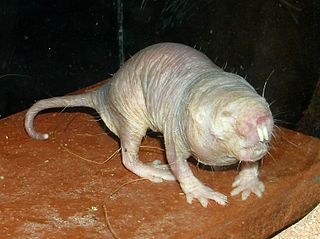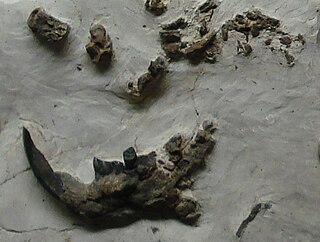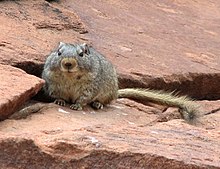
The Lacertidae are the family of the wall lizards, true lizards, or sometimes simply lacertas, which are native to Afro-Eurasia. It is a diverse family with at least 300 species in 39 genera. They represent the dominant group of reptiles found in Europe. The group includes the genus Lacerta, which contains some of the most commonly seen lizard species in Europe.

The family Castoridae contains the two living species of beavers and their fossil relatives. A highly diverse group of rodents within this family once roamed the earth, but only a single genus is extant today, Castor.

Ground squirrels are members of the squirrel family of rodents (Sciuridae), which generally live on or in the ground, rather than trees. The term is most often used for the medium-sized ground squirrels, as the larger ones are more commonly known as marmots or prairie dogs, while the smaller and less bushy-tailed ground squirrels tend to be known as chipmunks. Together, they make up the "marmot tribe" of squirrels, Marmotini, a division within the large and mainly ground squirrel subfamily Xerinae, and containing six living genera. Well-known members of this largely Holarctic group are the marmots (Marmota), including the American groundhog, the chipmunks, the susliks (Spermophilus), and the prairie dogs (Cynomys). They are highly variable in size and habitus, but most are remarkably able to rise up on their hind legs and stand fully erect comfortably for prolonged periods. They also tend to be far more gregarious than other squirrels, and many live in colonies with complex social structures. Most Marmotini are rather short-tailed and large squirrels. At up to 8 kg (18 lb) or more, certain marmots are the heaviest squirrels.

A dormouse is a rodent of the family Gliridae. Dormice are nocturnal animals found in Africa, Asia, and Europe. They are named for their long, dormant hibernation period of six months or longer.
The term rock rat has been used for several different types of rodents:

Glis is a genus of rodent that contains two extant species, both known as edible dormice or fat dormice: the European edible dormouse (Glis glis) and the Iranian edible dormouse. It also contains a number of fossil species.

Caviomorpha is the rodent infraorder or parvorder that unites all New World hystricognaths. It is supported by both fossil and molecular evidence. The Caviomorpha was for a time considered to be a separate order outside the Rodentia, but is now accepted as a genuine part of the rodents. Caviomorphs include the extinct Heptaxodontidae and extant families of chinchilla rats, hutias, guinea pigs and the capybara, chinchillas and viscachas, tuco-tucos, agoutis, pacas, pacaranas, spiny rats, New World porcupines, coypu and octodonts.

Abrocoma is a genus of abrocomid rodents found in the Andes of South America, from southern Peru to central Chile. The genus contains eight species, most of which are found in isolated mountain ranges in northwestern Argentina. The oldest fossil record for the Caviomorpha appears at the late Eocene-Early Oligocene transition.

The blesmols, also known as mole-rats, or African mole-rats, are burrowing rodents of the family Bathyergidae. They represent a distinct evolution of a subterranean life among rodents much like the pocket gophers of North America, the tuco-tucos in South America, or the Spalacidae from Eurasia.

The dassie rat is an African rodent found among rocky outcroppings. It is the only living member of its genus, Petromus, and family, Petromuridae. The name "dassie" means "hyrax" in Afrikaans, and the two animals are found in similar habitats. Petromus means "rock mouse" and dassie rats are one of many rodents sometimes called rock rats. The family and genus names are sometimes misspelled as Petromyidae and Petromys.

Petromus is a genus of hystricognath rodents that contains the dassie rat (Petromus typicus) of southwestern Africa, the only extant member of this group and the entire family Petromuridae.

Thryonomyidae is a family of hystricognath rodents that contains the cane rats (Thryomys) found throughout sub-Saharan Africa, and a number of fossil genera.

The rodent parvorder or infraorder Phiomorpha comprises several living and extinct families found wholly or largely in Africa. Along with Anomaluromorpha and perhaps the extinct Zegdoumyidae, it represents one of the few early colonizations of Africa by rodents.

The term Hystricomorpha has had many definitions throughout its history. In the broadest sense, it refers to any rodent with a hystricomorphous zygomasseteric system. This includes the Hystricognathi, Ctenodactylidae, Anomaluridae, and Pedetidae. Molecular and morphological results suggest the inclusion of the Anomaluridae and Pedetidae in Hystricomorpha may be suspect. Based on Carleton & Musser 2005, these two families are discussed here as representing a distinct suborder Anomaluromorpha.

Steneofiber is an extinct genus of beavers from the Miocene. They contain several species of beavers. Amongst them are S.barbouri, S.complexus, S.depereti, S.fossor, S.gradatus, and S.hesperus. Their various species are found all the way from the eastern end of the Iberian peninsula to southern Japan. S.depereti has been found in northwest Germany.

Cramauchenia is an extinct genus of litoptern South American ungulate. Cramauchenia was named by Florentino Ameghino. The name has no literal translation. Instead, it is an anagram of the name of a related genus Macrauchenia. This genus was initially discovered in the Sarmiento Formation in the Chubut Province, in Argentina, and later it was found in the Chichinales Formation in the Río Negro Province and the Cerro Bandera Formation in Neuquén, also in Argentina, in sediments assigned to the SALMA Colhuehuapian, as well as the Agua de la Piedra Formation in Mendoza, in sediments dated to the Deseadan. In 1981 Soria made C. insolita a junior synonym of C. normalis. A specimen of C. normalis was described in 2010 from Cabeza Blanca in the Sarmiento Formation, in sediments assigned to the Deseadan SALMA.

Eomyidae is a family of extinct rodents from North America and Eurasia related to modern day pocket gophers and kangaroo rats. They are known from the Middle Eocene to the Late Miocene in North America and from the Late Eocene to the Pleistocene in Eurasia. Eomyids were generally small, but occasionally large, and tended to be squirrel-like in form and habits. The family includes the earliest known gliding rodent, Eomys quercyi.
Propalaeocastor is a poorly known extinct genus of beavers from the early Oligocene of Europe and Asia. Recently described material of a new species of Propalaeocastor, P. irtyshensis, indicates the genus is probably the earliest known member of the subfamily Castorinae, which includes all castorids more closely related to living beavers than to the extinct giant beaver. Previously, Propalaeocastor had been allied with more basal beavers such as Agnotocastor and Anchitheriomys. According to Wu and coauthors, Propalaeocastor, specifically P. butselensis, is the likely ancestor of the better-known Eurasian castorine Steneofiber.
This paleomammalogy list records new fossil mammal taxa that were described during the year 2013, as well as notes other significant paleomammalogy discoveries and events which occurred during that year.
This paleomammalogy list records new fossil mammal taxa that were described during the year 2010, as well as notes other significant paleomammalogy discoveries and events which occurred during that year.
















